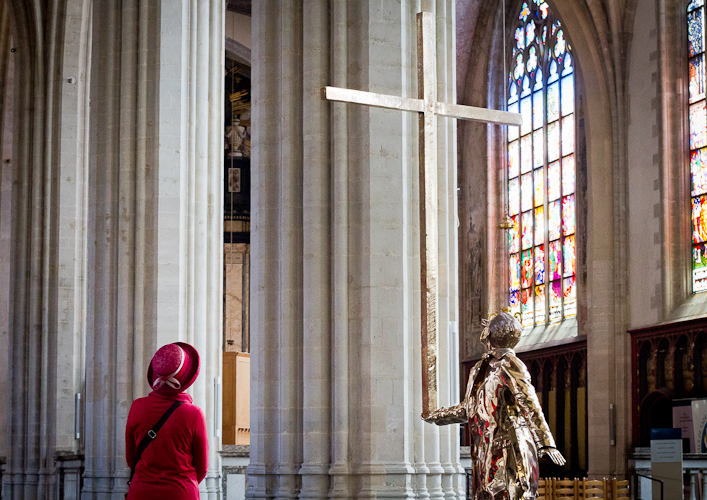What Happens When You Die? he asked (Part 2)
Picture: Stuck in Customs
So, as I mentioned last week, I recently had an interesting conversation in a bookstore with a guy named Andy. ‘What happens when you die?’ Andy had asked me. After we’d discussed the relationship between science and faith and a few other things, Andy needed to serve a customer. When he returned he was keen to pick up the conversation, though starting to get some looks from his workmates who were starting to close the shop.
‘Here’s one more thing to think about,’ I said, realising it was time to let Andy get back to work.
‘What’s that?’ he said.
‘If you really want an answer to your question of what happens after death,’ I said, ‘you’ll need to seriously explore the claim that Jesus of Nazareth was resurrected. If he did return to life, as the Christian faith says, then there’s at least one case in history of a person proving death is not the end.’
The Resurrection of Jesus
All four New Testament accounts of Jesus’ life tell this basic story:
Jesus of Nazareth, a Jewish carpenter who claimed to be the Messiah, went around Galilee and beyond doing remarkable miracles and forgiving sins. He was arrested, judged to be a political criminal, and crucified. Three days after his death and burial, his tomb was found open and empty. His followers soon claimed that God had raised Jesus from the dead and that he’d appeared to them before ascending to heaven.
If you haven’t read the story directly, the ending to Mark’s version can be read in a few minutes. But the natural question to a modern, scientific mind is this: Did it really happen? Did Jesus really return to life after death? Bodily? Historically? Both affirmations and challenges to this claim have been made over the years. Here are 12 points in summary:
1. The Gospel accounts of Jesus’ resurrection are recognised as historical texts within the mainstream academic community. While their stories of Jesus have been compiled with a theological purpose in mind, they are to be read as history, not myth.
2. Jesus’ resurrection was not a privately-witnessed event, relying on one or two testimonies. After his death, Jesus is said to have appeared first to Mary Magdalene and her two friends, then the disciples and more than 500 others. Some have claimed the disciples suffered from hallucinations after Jesus’ death. It’s hard to fathom how 500 people could all hallucinate the same thing at the same time.
3. Many security precautions were taken with Christ’s tomb. Roman guards were posted and a seal was placed on it. The guards risked the death penalty by abandoning their post. The penalty for breaking the seal was crucifixion upside down. With such consequences who would risk either action, and for what gain?
4. The giant stone rolled over the entrance of the tomb would’ve been around 1-2 tonne in weight. It would take a number of strong men to move, after dealing with the guards – hardly something a few frightened Jesus followers could do in the quiet of night.
5. Something must account for the life change in Jesus’ first followers after the resurrection is claimed to have happened. Only moments before Jesus’ death his friend Peter denied knowing him and the other disciples abandoned him, fearing for their lives. Yet afterward they all faced constant death threats, and were in fact martyred brutally, for preaching about the resurrected Jesus. Again, to what end, unless it was true?
6. Something must account for Saul of Tarsus’ dramatic transformation from persecutor of the early Christians to bold-hearted missionary. As mentioned, Paul was later martyred (beheaded by Emperor Nero) for being a Christian. That’s a big price to pay for a lie or an illusion. The best explanation is that he really did meet with the resurrected Christ.
7. Something must account for the phenomenal rise of the Christian church. As Professor John Lennox has put it, Jesus was no ‘hero’ in either the Jewish, Roman or Greek mind. People don’t rush to follow a ‘failed’ Messiah crucified as a common criminal. And yet within weeks, the Christian church had grown into the thousands.
Historian-theologian NT Wright has done the most significant research into Jesus’ resurrection in recent years. His mammoth tome [amazon_link id=”0800626796″ target=”_blank” container=”” container_class=”” ]The Resurrection of the Son of God[/amazon_link] is 848 pages thick, but thankfully he has distilled his findings (see also his entertaining speech Can a Scientist Believe in the Resurrection?). As an historian, Tom Wright makes some additional important points on the story of Jesus’ resurrection:
8. Jesus’ resurrection dramatically changed the way the word was understood. For a start, there was no ‘spectrum of belief’ about resurrection by the early Christians, even though they came from vastly different cultural backgrounds (think about how many understandings there are about, say, the Lord’s Supper between denominations today). Secondly, while resurrection wasn’t that important in Jewish teaching, it became central for the early Christians and the New Testament writers. Why, unless it really happened?
9. The Gospel writers don’t link the resurrection with the Old Testament. Matthew, Mark, Luke and John quote the Old Testament heavily in their stories of Jesus, showing how he fulfilled Jewish hopes – until they get to the resurrection. Why? Wright sees this as evidence for the resurrection story’s authenticity and early writing. It was written as a new incredible fact before there had been any time for biblical reflection on it.
10. Women were the first witnesses of Jesus’ resurrection. This is important. The sad reality is that women were not regarded as credible witnesses in the ancient world. Nobody wanting to fabricate a story like this and have it believed would have women playing such a role. It is a significant feature of the resurrection story’s authenticity.
11. Another feature is the portrait of Jesus himself. As Wright says, ‘If, as many revisionists have tried to make out, the gospel stories developed either from people mulling over the scriptures following Jesus’s death or a new experience of inner illumination, you would expect to find the risen Jesus shining like a star… But none of the gospels say this about Jesus at Easter. Indeed, he appears as a human being with a body that in some ways is quite normal, and can be mistaken for a gardener, or a fellow traveller on the road.’
12. And why is there no mention of our resurrection in the stories? ‘Almost everywhere else in the New Testament,’ Wright says, ‘the resurrection of Jesus is spoken of in connection with the final hope that those who belong to Jesus will one day be raised as he has been. Once again, had the stories been invented towards the end of the first century this interpretation would certainly have included a mention of the final resurrection of all God’s people.’
Alternative Explanations
There have always been questions raised about Jesus’ resurrection. The Bible records them happening from the beginning, and critics today find the idea of Jesus overturning the laws of nature to return to life incredible. A variety of alternative explanations have been offered for what happened. We could group them into Natural, Mythical and ‘Spiritual’ explanations for Jesus’ resurrection:
Natural Explanations
- The swoon explanation: Jesus simply passed out and woke up in the grave.
- The conspiracy explanation: Jesus’ body was stolen from the grave.
- The hallucination explanation: Jesus’ disciples saw him in their minds only, not in the flesh.
- The body-switch explanation: Islam teaches that Jesus wasn’t crucified – he was simply raised to heaven – and that the body in the tomb was a switch.
- The ‘wrong tomb’ explanation: Mary Magdalene and the other women got the tombs mixed up.
Mythical Explanations
- The ‘evolving legend’ explanation: The Gospels were written decades after Jesus’ life and death. As a result, a legend of Jesus’ ‘spiritual’ resurrection evolved into one of physical resurrection.
- The ‘mythic story’ explanation: Mythicists note that there are pagan parallels to the resurrection story, like the stories of the Greek gods Dionysus and Adonis, and the Egyptian god Osiris, who all die and and rise again. The Jesus story, it is claimed, is simply a Christianising of these myths.
‘Spiritual’ Explanations
- The ‘Jesus rose as a spirit’ explanation: Some people didn’t recognise Jesus after his resurrection. Jesus is said to have been able to pass through walls after his resurrection. Doesn’t that mean Jesus wasn’t really raised as a physical person?
Most if not all of these alternative views are easily countered by the 12 points mentioned above. However, in the interview below you will hear them explored in even more detail. Ross Clifford is principal of Morling College in Sydney, Australia. His books include [amazon_link id=”1896363024″ target=”_blank” container=”” container_class=”” ]Leading Lawyer’s Case for the Ressurection[/amazon_link] and, with Philip Johnson, [amazon_link id=”0801014611″ target=”_blank” container=”” container_class=”” ]The Cross is Not Enough[/amazon_link]. He is a fine expert on the resurrection and has some brilliant things to say.
So, did Jesus’ resurrection really happen?
‘In any other historical enquiry,’ Tom Wright says, ‘the answer would be so obvious that it would hardly need saying: the best explanation is that it happened. All the signposts are pointing in one direction.’
The resurrection really happened.
Jesus rose from the dead.
Bodily. Historically.
And That Means?
And that means at least One person in history has proved that death is not the end. It means One person has conquered the ultimate human enemy. It means One person knows the way to life beyond the grave, and it means his claim of being the One True Guide there should be taken seriously. Don’t you think?
‘I am the resurrection and the life. The one who believes in me will live, even though they die… Do you believe this?’
~ Jesus
***
Question: What do you believe about Jesus’ resurrection and its significance? Have I missed anything? Share your comment now.
***
Listen to the Ross Clifford interview below, or right click here and ‘save target’ to download.






JCKelley1970
Jesus Christ was not the only body resurrected that day. I do not recall the specific passage but there is mention that many arose (from their graves near Jerusalem) that same day who believed He was the Son of God.
Sheridan Voysey
I think you’re referring to Matthew 27:51-53. Jesus brought Lazarus back from the dead also. The one difference between these events and Jesus’, of course, is that they died again while Jesus didn’t. Still, it shows that when it comes to the issue of life after death, Jesus as at the centre of all these stories.
Thanks for your comment.
purjay
You use a simple ”Logic” to ”prove” the resurrection,however, one could use exactly the same logic to disprove what is after all, an article of faith. I do believe that one should profess one’s faith, not justify it.
Sheridan Voysey
I don’t think I use the word ‘prove’ once in this post, Purjay, as I’m not sure it’s a helpful word to use when we’re talking about history. But neither do I see any problem in outlining historical information that points strongly towards a truth claim. We do that in all other fields, so why not in matters of faith too?